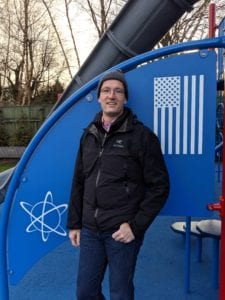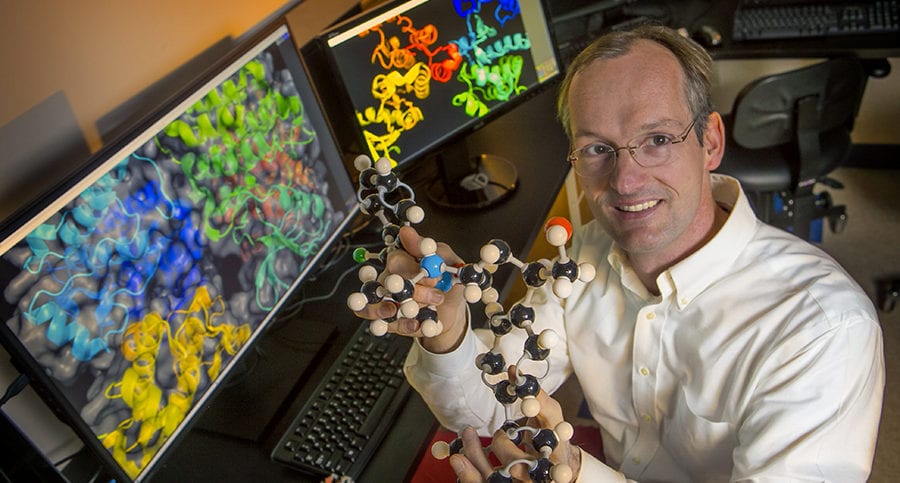By Daniel Dunaief
They are like couples looking for each other on a dating website. Each side could theoretically find a range of connections. The focus in this dating game, however, has heavily favored understanding the preferences of one side.
Markus Seeliger, an associate professor in the Department of Pharmacological Sciences at the Stony Brook University Renaissance School of Medicine, has taken important steps to change that, albeit in a completely different area. Instead of working with two people who are searching for a date, Seeliger studies the interactions among protein kinases, which are like switches that turn on or off cellular signals, and inhibitors, which researchers and drug companies are creating to slow down or stop the progression of diseases.

Most scientists have looked at the pairing of these molecules and protein kinases from the perspective of the inhibitor, trying to figure out if it would bind to one of the 500 protein kinases in the human body.
Seeliger, however, is exploring the coupling from the other side, looking at the selectivity of the kinases. He published recent research in the journal Cell Chemical Biology.
“People have only ever looked at the specificity from the point of view of an inhibitor,” Seeliger said. “We’ve turned it around. We’re looking at it from the perspective of kinases,” adding that kinases have been important drug targets for decades.
In an email, Michael Frohman, a SUNY distinguished professor and the chair of the Department of Pharmacological Sciences, applauded Seeliger’s efforts and said his research “is representative of the innovative work going on in many of the labs here.”
On a first level, Seeliger discovered eight kinases that bind to a range of potential inhibitors, while the others are more selective.
Within the smaller group that binds a range of inhibitors, there was no sequence relationship between the base pairs that formed the kinases. The kinases are also not closely related in the cellular functions they regulate. They all trigger similar signaling cascades.
Seeliger wanted to know why these eight kinases were four to five times more likely to couple with an introduced inhibitor than their more selective kinase counterparts. The Stony Brook scientist performed a three-dimensional analysis of the structure of one of these kinases at Brookhaven National Laboratory.
“They have a very large binding pocket that can accommodate many different inhibitors,” Seeliger said. Indeed, he discovered this higher level of receptivity by separating out this group of eight, which also had more flexible binding sites. If the match between the configuration of the inhibitor and the kinase isn’t perfect, the kinase can still find a way to allow the molecule to connect.
For any potential inhibitor introduced into the human body, this more flexible and accommodating group of kinases could cause unintended side effects regardless of the level of specificity between the inhibitor or drug and other targets. This could have health implications down the road, as other researchers may use the properties of these kinases to switch off programs cancer or other diseases use to continue on their destructive paths.
“Studies point to the roles of protein kinases as driving (to at least allowing and permitting) cancer growth and development,” Yusuf Hannun, the director of the Stony Brook University Cancer Center, explained in an email. “Therefore, one needs to inhibit them.”
Hannun described Seeliger as “very rigorous” and suggested he was an “up and coming scientist” whose “novel approach” shed significant new light on protein kinases.
In his research, Seeliger’s next step is to look at the existing database to see what other groups of kinases he finds and then determine why or how these switches have similarities to others in other systems or regions of the body.
Seeliger likened kinases to a control panel on a space shuttle. “Nothing about the sequence tells you about the role of the switches,” which would make it difficult for astronauts to know which switch to turn and in what order to bring the shuttle home.
Another question he’d like to address involves a greater understanding of the complexity of a living system. So far, he’s looked at properties of these kinases under controlled conditions. When he moves into a more complex environment, the inhibitors will likely interact and yield unexpected binding or connections.
Frohman appreciated Seeliger’s overall approach to his work and his contribution to the field. He cited the popularity of a review article Seeliger wrote that documents how drug molecules find their target binding site. Frohman said this work, which was published in the Journal of the American Chemical Society, was cited over 400 times in other articles.
Seeliger has been “very dedicated to moving this field forward. We were very excited about the topic and have been very pleased with the work he’s done on it since arriving at SBU,” Frohman said.
A resident of Stony Brook, Seeliger lives with his wife Jessica Seeliger, an assistant professor in the Department of Pharmacological Sciences who works on developing drugs for tuberculosis. The couple has two young children.
“We are all very happy they are both here as independent scientists,” Frohman added.
Indeed, Hannun called Jessica Seeliger an “outstanding and highly talented scientist,” as well.
Seeliger grew up in Hanover, Germany. He became interested in science in high school when he watched “The Double Helix,” which showed the development of the structural model of DNA.
His lab currently has two postdoctoral researchers and two doctoral candidates. Ultimately, Seeliger hopes his research helps establish an understanding of the way various kinases are functionally similar in how they interact with drugs.
“We wish we would be able to design more specific inhibitors without having to test dozens and dozens of compounds by trial and error,” he explained. He hopes to continue to build on his work with kinases, including exploring what happens when mutations in these switches cause disease.







